| Réunion des pascaliens de Da Nang au Café Boon. Le Café est géré par Huỳnh thị Như Nguyệt et Trần thị Thêm, deux étudiantes de Dai Hoc Kinh Te. Ce projet est soutenu par Dong Hanh et financé par l’Amicale BPDN, dans le but de servir de la nourriture saine et bon marché aux étudiants. Les pascaliens présents : Vĩnh Khoa(BP68), Lê thị Nhân Hạnh(BP70), Lê Hiệp Tuyển(BP70), Định Vy Cư(BP70), Đinh thị Bích(BP71), Hồ thị Minh Tâm(BP71), Tống Văn Thụy(BP71), Trương Chí Luận(BP72), Vĩnh Khánh(BP76) 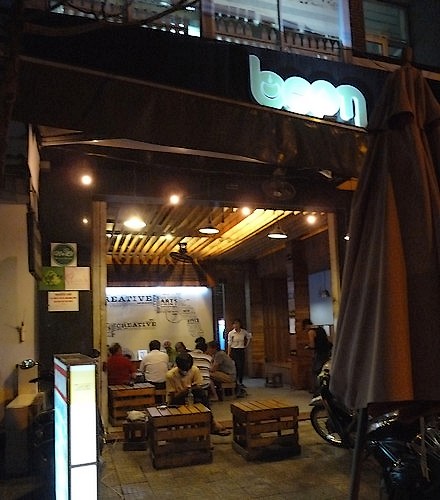 BOON – 43 Pasteur Da Nang BOON – 43 Pasteur Da Nangouvert tous les jours, de 17h30 a 22h30 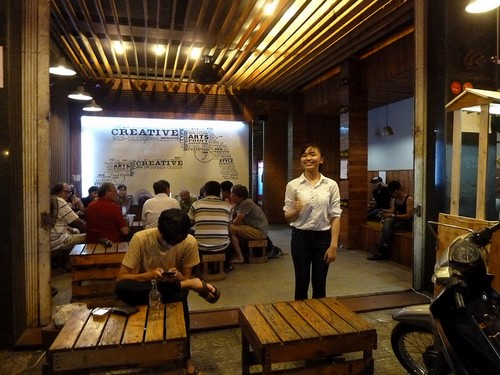 Boon et la jeune entrepreneure Boon et la jeune entrepreneure 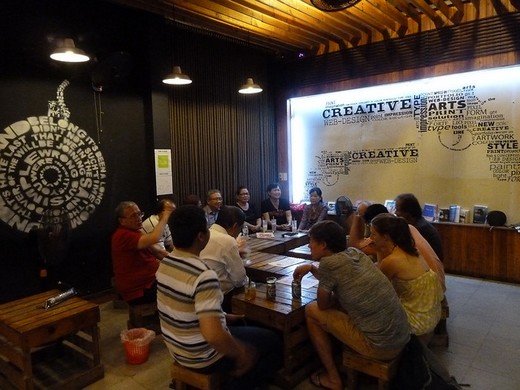 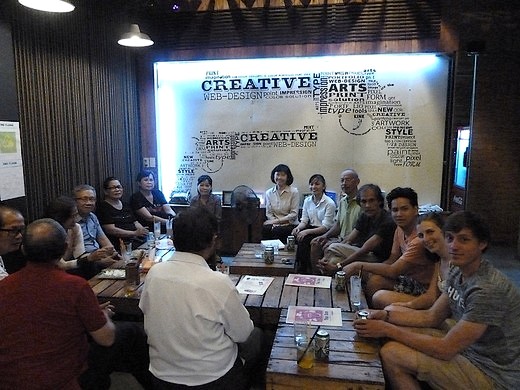 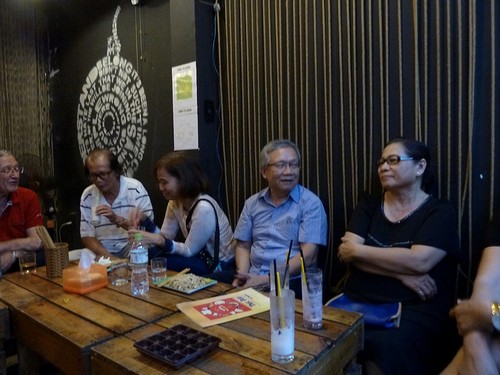 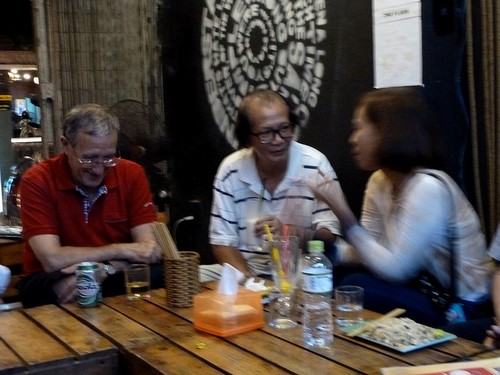 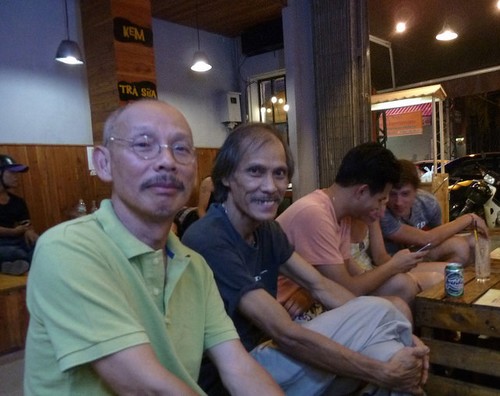 Vĩnh Khoa BP68 – Vĩnh Khánh NH76 Vĩnh Khoa BP68 – Vĩnh Khánh NH76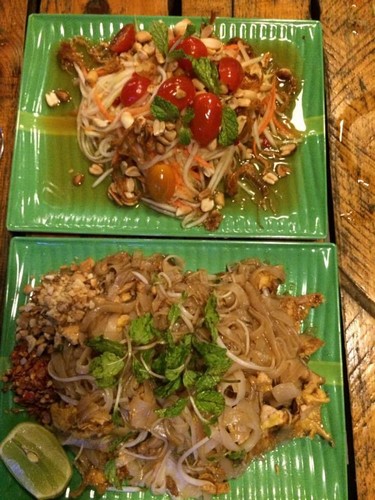 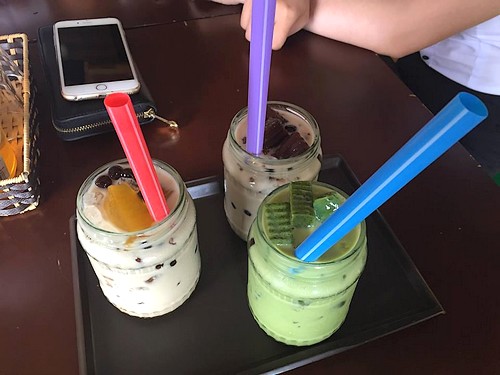 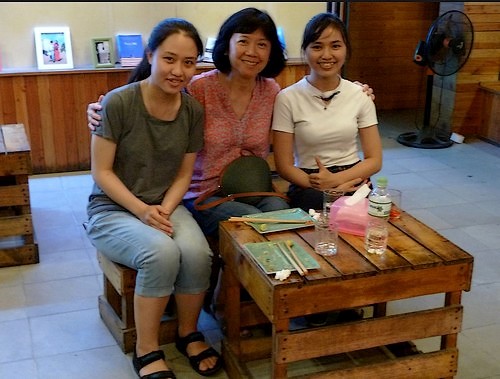 Huỳnh thị Như Nguyệt et Trần thị Thêm, les deux responsables du Café Huỳnh thị Như Nguyệt et Trần thị Thêm, les deux responsables du Café |
Auteur : min tamh
Da Nang Tet 2017-
| Tết Đinh Dậu à Da Nang, en compagnie des amis et de la famille. Sont présents : Nguyễn thị Lương Nhụy(BP59), Trần thị Lệ Tuyết(BP69), Lê thị Nhân Hạnh(BP70), Định Vy Cư(BP70), Trần thị Như Mai(BP71), Đinh thị Bích(BP71), Hồ thị Minh Tâm(BP71), Tống văn Thụy(BP71), Trương Chí Luận (BP72), Ngô thị Hồng Huệ (NH77) .  Tokyo BBQ – Mồng 2 Tết Đinh Dậu (29 Jan 2017) Tokyo BBQ – Mồng 2 Tết Đinh Dậu (29 Jan 2017) 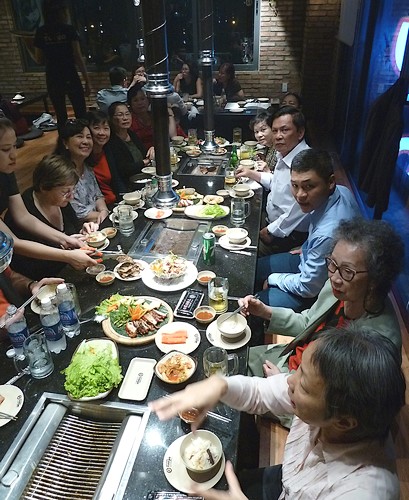 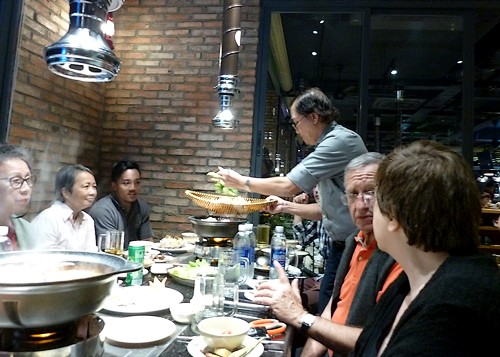 Tống văn Thụy (BP71) en plein travail… Tống văn Thụy (BP71) en plein travail…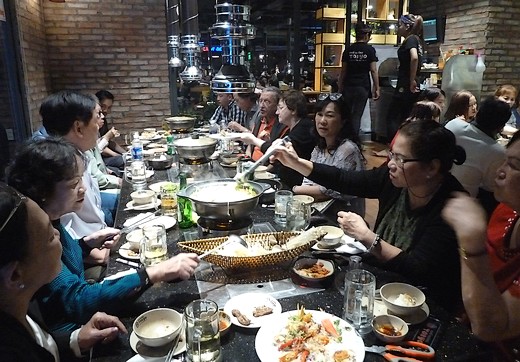 Lê thị Nhân Hạnh (BP70) aussi… Lê thị Nhân Hạnh (BP70) aussi… 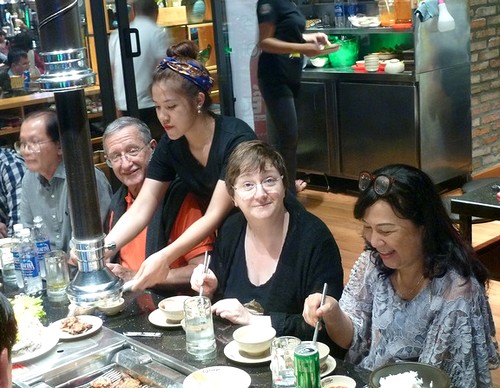 … et ceux qui se laissent servir … et ceux qui se laissent servir 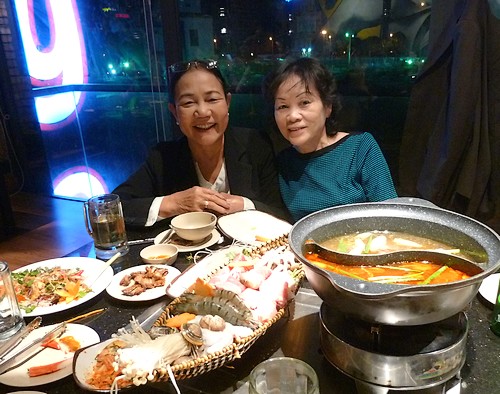 Trần thị Lệ Tuyết (BP69) – Định Vy Cư (BP70) Trần thị Lệ Tuyết (BP69) – Định Vy Cư (BP70) 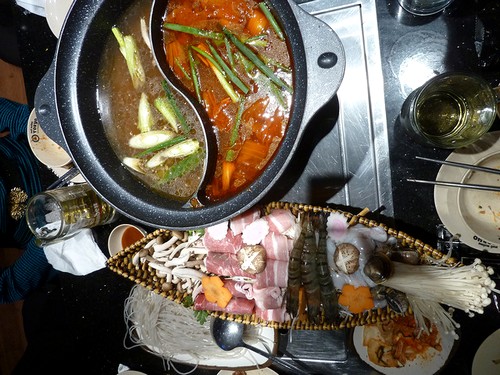 Fondue aux deux saveurs Fondue aux deux saveurs 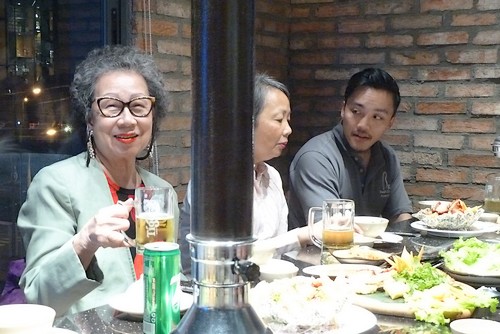 Nguyễn thị Lương Nhụy (BP59) Nguyễn thị Lương Nhụy (BP59) 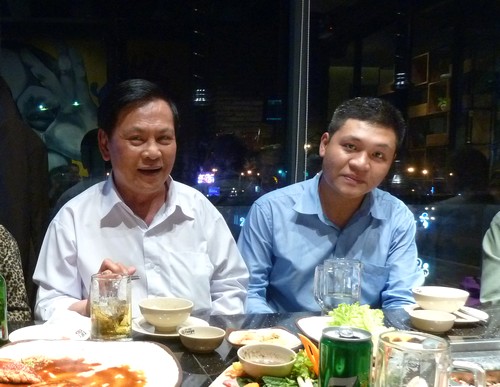 Trương Chí Luận (BP72) et son fils Bảo Trương Chí Luận (BP72) et son fils Bảo 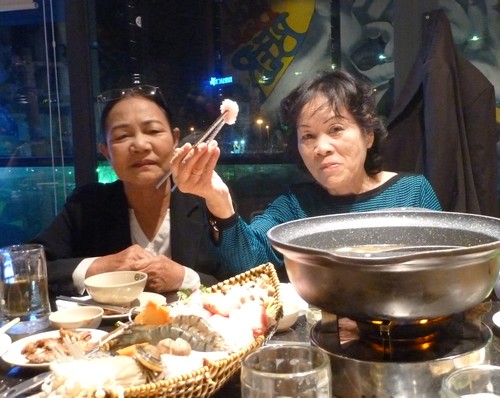 Bon appetit! Bon appetit!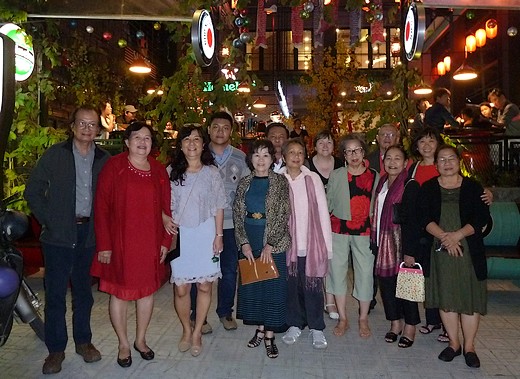 Mến chúc các Bạn một năm Đinh Dậu Mọi Sự Như Ý Mến chúc các Bạn một năm Đinh Dậu Mọi Sự Như Ý |
San Jose, Septembre 2016-
Accueil de leurs deux professeurs, Hứa Lạc Thành BP68 et Tống văn Thụy BP71, par les anciennes élèves du lycée Hồng Đức – DNG, avant leur Grande Reunion à San Jose, Septembre 2016 . 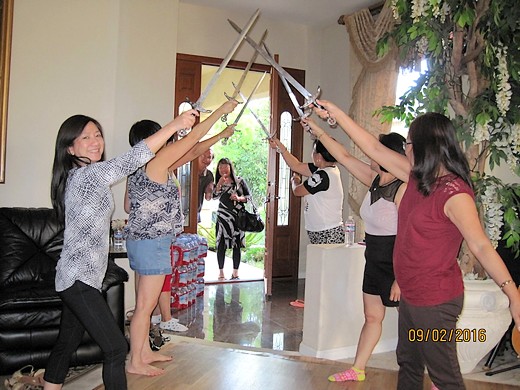 Un accueil digne des descendantes de Hai Bà Trưng! Un accueil digne des descendantes de Hai Bà Trưng!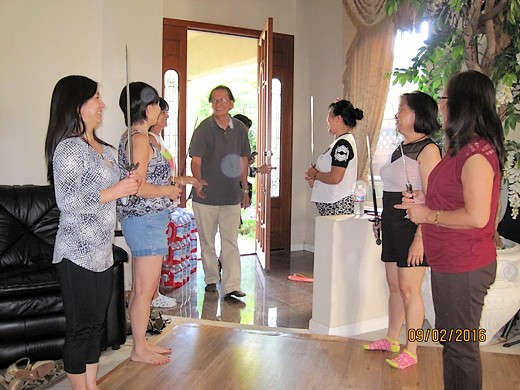 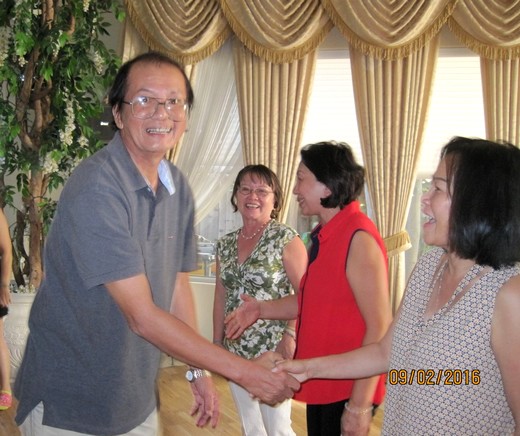 Thầy Thụy và các em tay bắt mặt mừng, vui quá hỉ! Thầy Thụy và các em tay bắt mặt mừng, vui quá hỉ!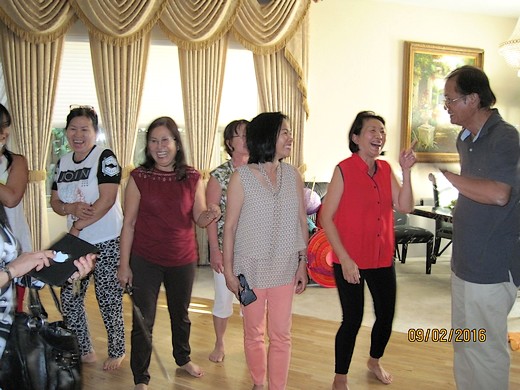 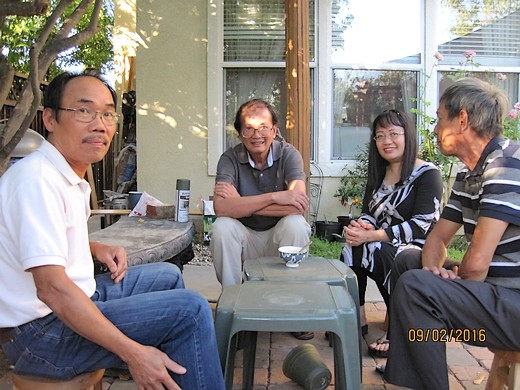 . ._-_ °°° _-_ 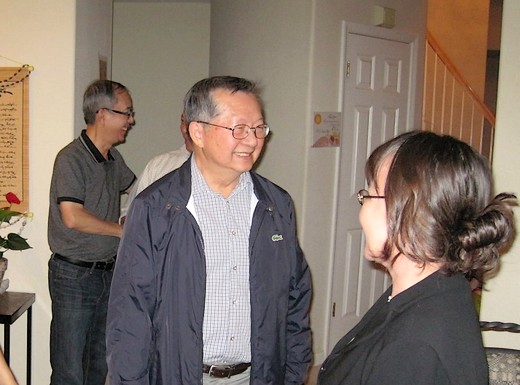 Thầy Thành viếng học trò cũ trước Đại Hội Hồng Đức 2016 tại San Jose Thầy Thành viếng học trò cũ trước Đại Hội Hồng Đức 2016 tại San Jose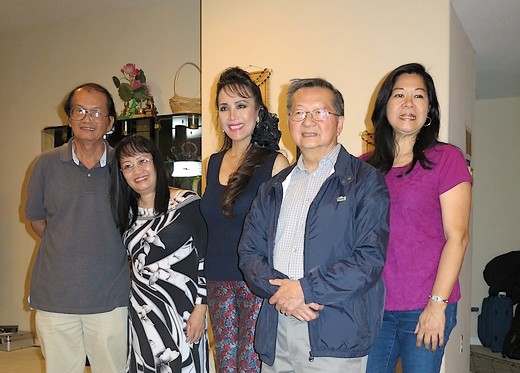 TRƯỜNG NỮ TRUNG HỌC HỒNG-ĐỨC ĐÀ-NẴNG http://nutrunghocdn.com/Truong_Xua/Tieu_Su_Truong/Tieu_Su_Truong.html |
Meudon – Juillet 2016-
Reunion chez Thierry et Nhu Mai Paturle, avec la participation de Huynh Do Thuy Mai, Phan Tan Hao, Claude Carrobourg, Nguyen thi Luong Nhuy, Claude et Huguette Poignard, Nguyen Bui Nhan et Ai Chi (Australie), MT, Roger et les amis. 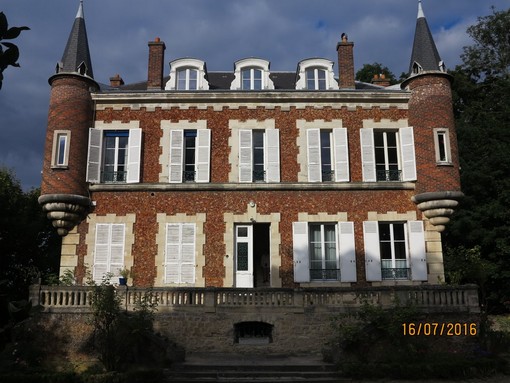 Les Tourelles par un apres-midi d’ete nuageux… Les Tourelles par un apres-midi d’ete nuageux…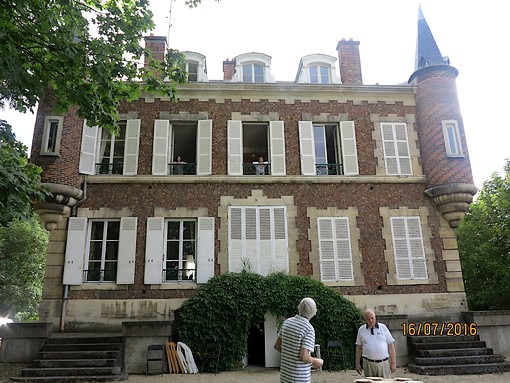 Du haut des Chambres Hautes, deux “ingenieuses des travaux finis” prodiguent des conseils pour dresser la table… Du haut des Chambres Hautes, deux “ingenieuses des travaux finis” prodiguent des conseils pour dresser la table…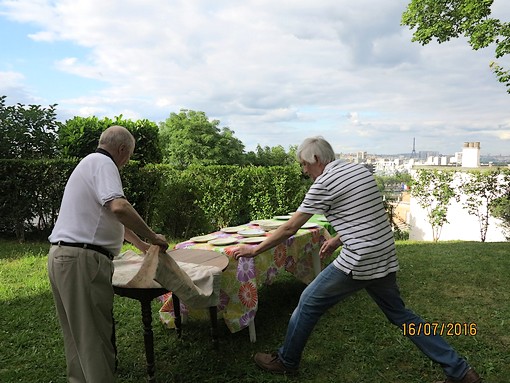 … que Thierry et Claude executent avec brio! … que Thierry et Claude executent avec brio!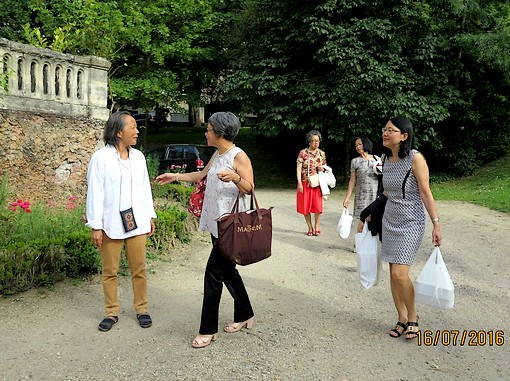 Les convives et les approvisionnements arrivent… Les convives et les approvisionnements arrivent… 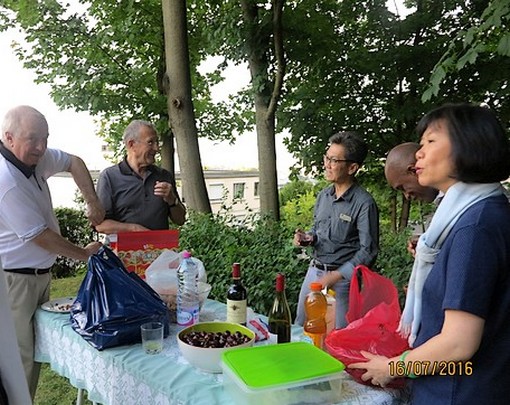 Où met-on le tiramisu? Où met-on le tiramisu?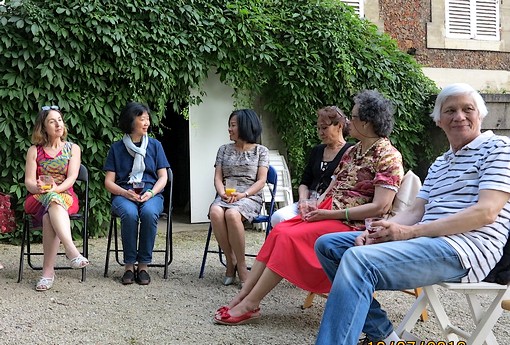 Causerie et cerises en attendant le repas Causerie et cerises en attendant le repas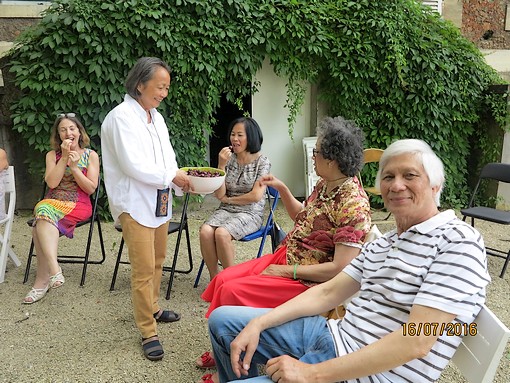 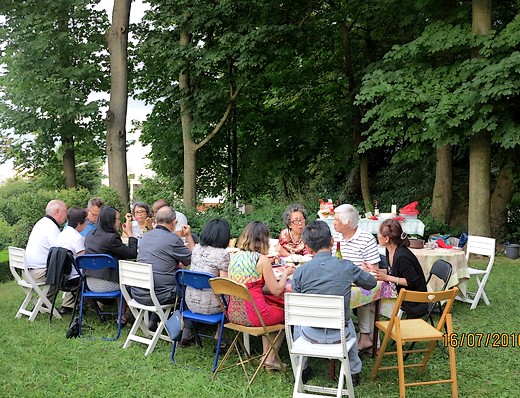 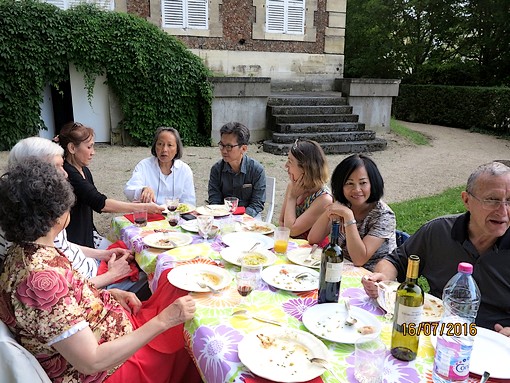 Les banh beo et les banh bot loc partent à la vitesse grand V! Les banh beo et les banh bot loc partent à la vitesse grand V!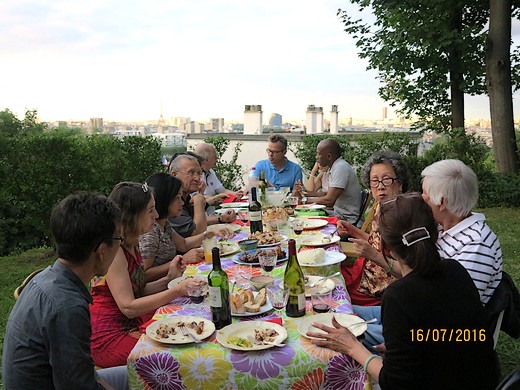 Le repas continue dans la convivialite avec une multitude de plats et de desserts… Le repas continue dans la convivialite avec une multitude de plats et de desserts…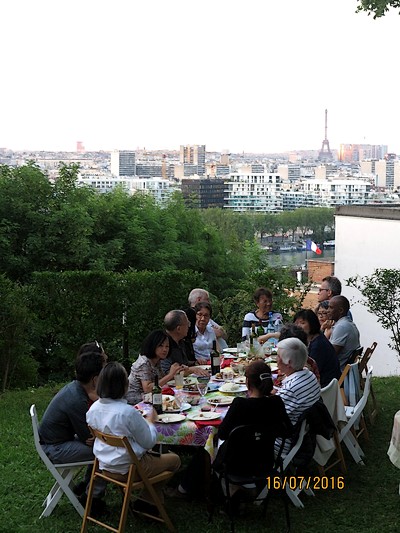 … jusqu’à la tombée de la nuit. … jusqu’à la tombée de la nuit. Merci à Mai et Thierry Paturle pour ce moment partagé Merci à Nguyen Bui Nhan pour ce reportage-photos |
Paris, Juillet 2016-
| Sortie BP pour tester un nouveau restaurant, nommé “Gạo”. Sont venus : Cô Bùi thị Lý, Mme Tuyết Trihoreau, Thierry Paturle (NH), Nguyen thi Luong Nhuy (BP60), Nguyen thi Nhu Lai (BP63), Le Thach Truc (BP63), Chung Cao Thang (BP62), Hien Maziere (BP64), Tran thi Nhu Mai (BP71), Minh Tam (BP71), Huynh Do Thuy Mai, Phan Than Hao (BP74), Nguyen Bui Nhan (BP74) et Ai Chi, Nguyen Huu Hong Vu (BP74) et Kim Cuc ainsi que quelques membres de leurs familles. 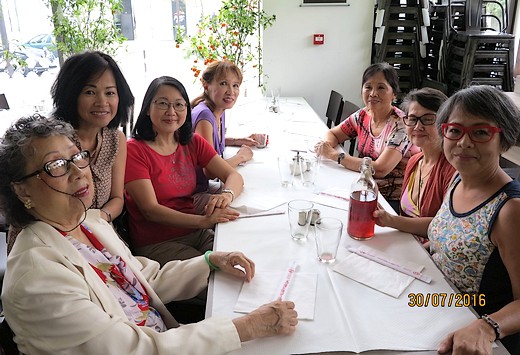 Les premiers arrivants (cad ceux qui ne se perdent pas en route… !) Les premiers arrivants (cad ceux qui ne se perdent pas en route… !)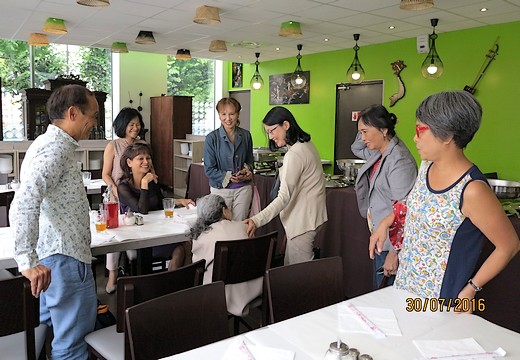 Cô Lý fait l’objet de toutes les attentions … Cô Lý fait l’objet de toutes les attentions …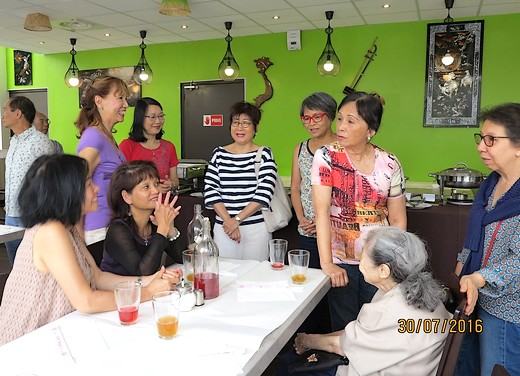 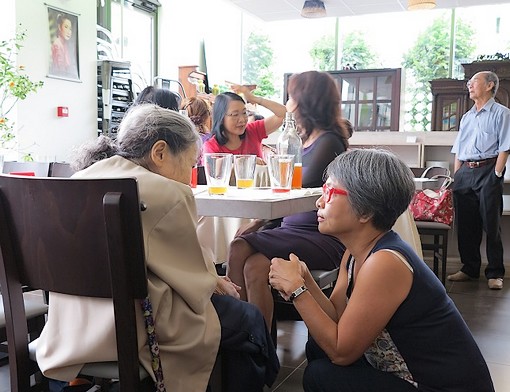 Confession d’une ancienne élève… Confession d’une ancienne élève…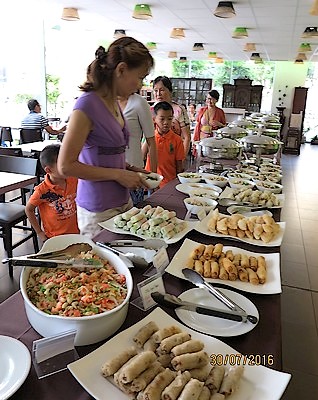 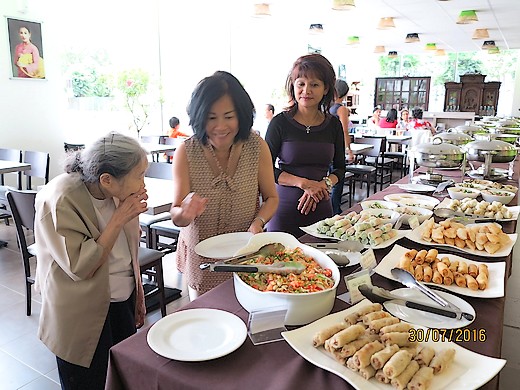 Cô ăn chi con lấy cho… Cô ăn chi con lấy cho…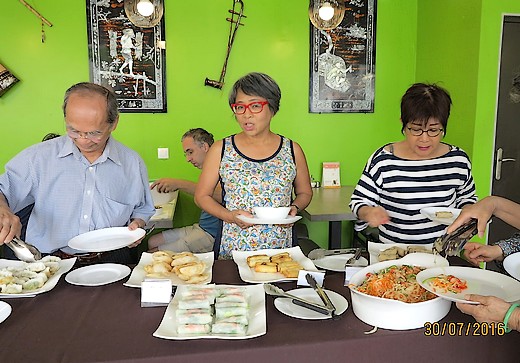 Anchi dayta ? Anchi dayta ?(Hao pratique son japonais) 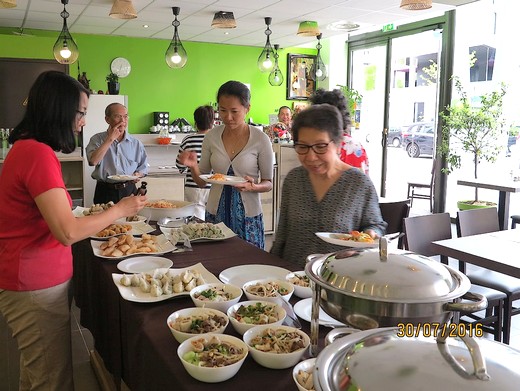 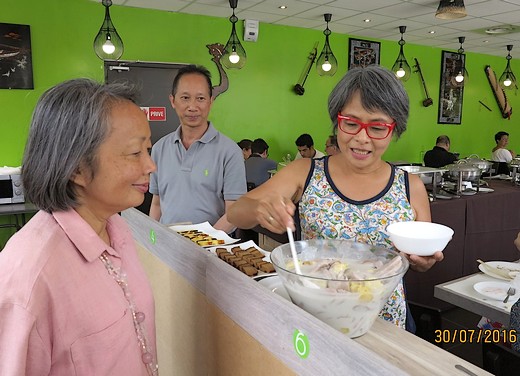 Ah, du chè chuối comme à la maison! Ah, du chè chuối comme à la maison!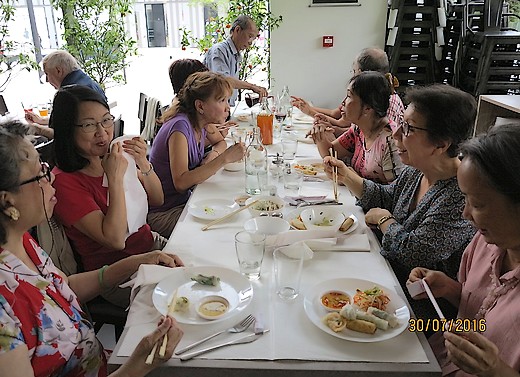 On a bien mangé, maintenant on va causer 🙂 On a bien mangé, maintenant on va causer 🙂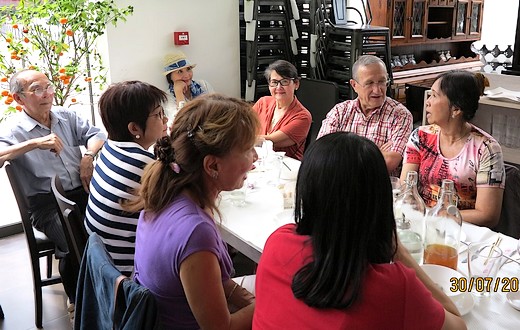 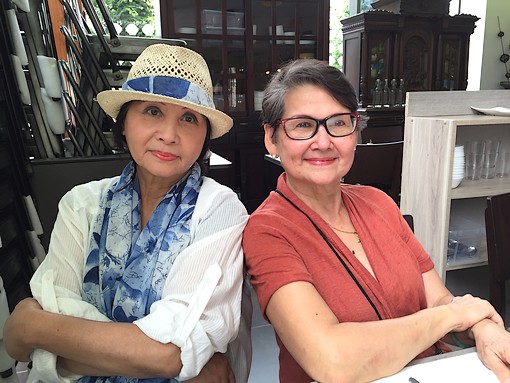 Thạch Trúc et Như Lai du Collège Francais de Tourane Thạch Trúc et Như Lai du Collège Francais de Tourane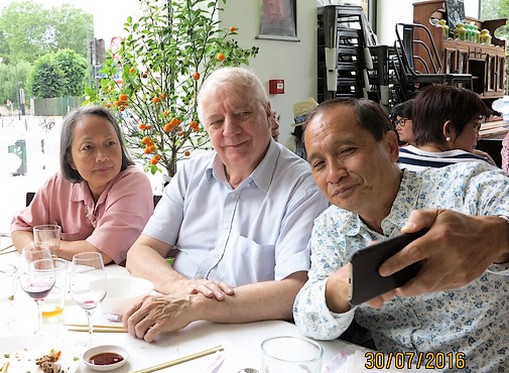 Hong Vu montre l’art de transformer un petit studio en un studio “grande classe”, confort deluxe Hong Vu montre l’art de transformer un petit studio en un studio “grande classe”, confort deluxe. 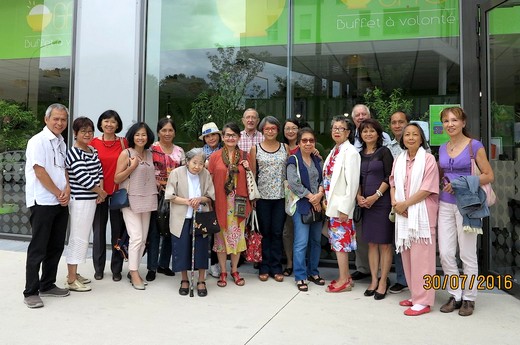 Apres “Gạo”, on ira un jour tester “Bún” ou “Phở” ? Apres “Gạo”, on ira un jour tester “Bún” ou “Phở” ? 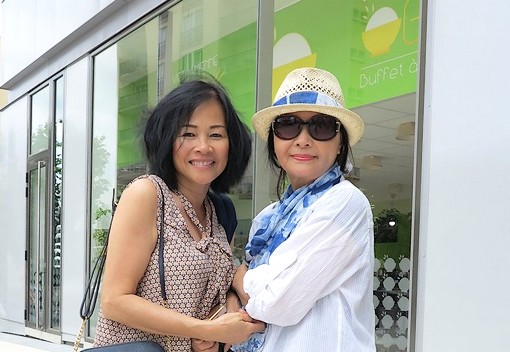 Ái Chi et chị Thạch Trúc sont prêtes pour une autre sortie culinaire … Ái Chi et chị Thạch Trúc sont prêtes pour une autre sortie culinaire … |
Dans le jardin
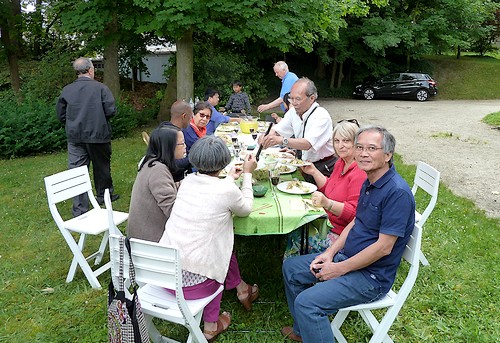 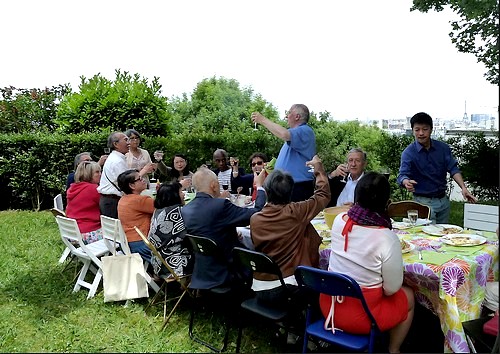 A l’amitié! A l’amitié!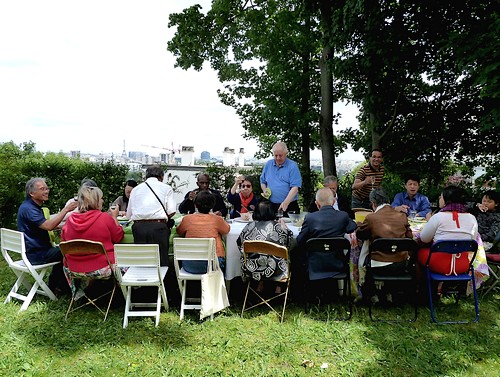 … et à notre santé … et à notre santé! 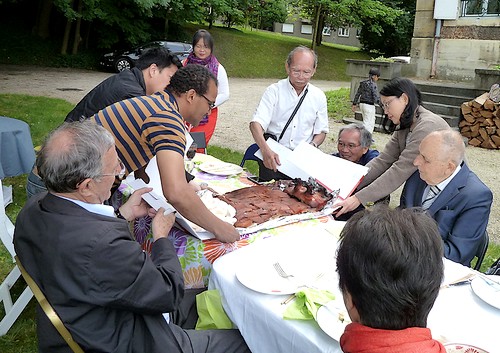 L’installation du plat principal L’installation du plat principal 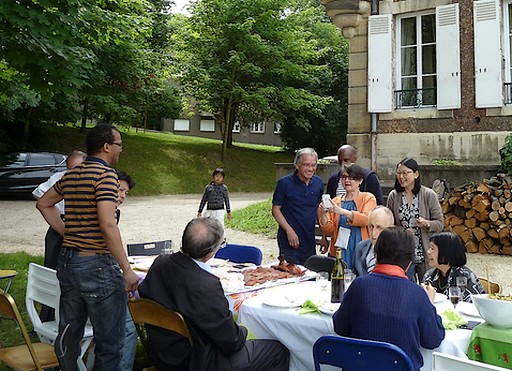 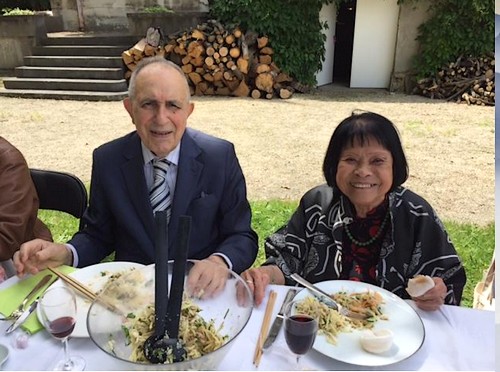 M.Mme René SAZERAT M.Mme René SAZERAT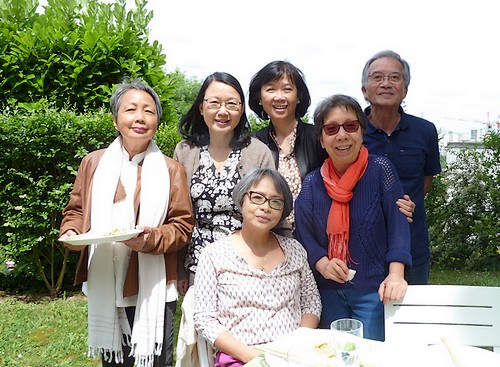 Như Mai, Thúy Mai, Minh Tâm, Claude, Vĩnh Nhẫn, Tấn Hảo Như Mai, Thúy Mai, Minh Tâm, Claude, Vĩnh Nhẫn, Tấn Hảo 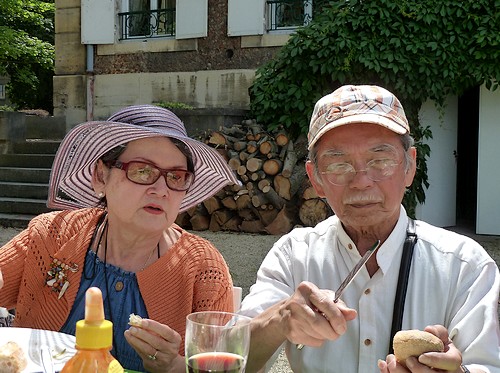 Như Lai, Cao Thắng Như Lai, Cao Thắng 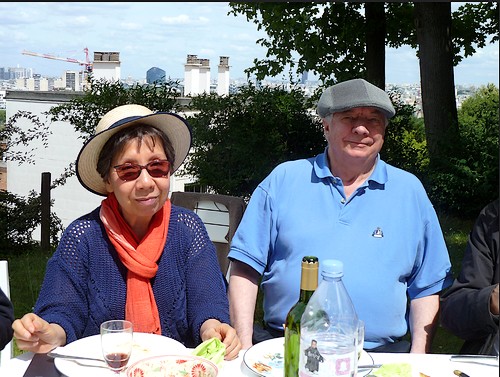 Claude, Thierry Claude, Thierry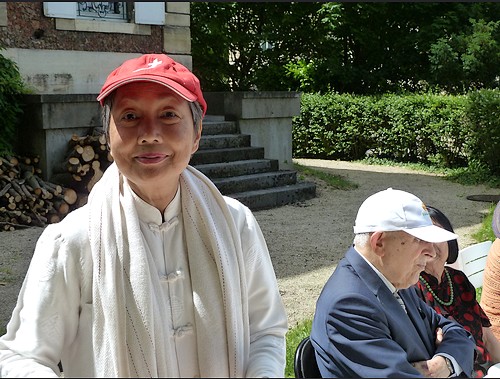 Merci à Nhu Mai et Thierry pour leur chaleureuse hospitalité! Merci à Nhu Mai et Thierry pour leur chaleureuse hospitalité! |
Cuvée Bac 2007
Geographie
. Le Mont Blanc est a 4 807 metres au dessus du niveau de la mer, sauf quand la mer monte.
Ile de France est une grande ile au milieu de la Seine.
•La Terre serait recouverte de glace s’il n’y avait pas les volcans pour la chauffer de l’interieur.
•Autrefois, la Belgique s’appelait le Congo beige.
II est triste de penser que le pôle Nord et le pole Sud ne se rencontreront jamais.
Histoire
•Quand on I’a brulée [ndlr : Jeanne d’Arc], les gens ont senti une odeur de saintete.
• Les pauvres s’appelaient sans-culottes car ils n’avaient pas les moyens de s’acheter un slip.
. Pour arreter les Allemands, les Francais avaient construit le mur de Berlin.
• C’est Bob Dylan qui a remplace Kennedy a la presidence.
• Quand it y a des problemes dans le monde, I’ONU envoie des casquettes bleues.
Musique
• II y a deux musiciens qui s’appellent Bach : Jean-Sebastien et Jean-Offen.
• Quand on studie la musique chez soi, on fait de la musique au logis.
• Comme son nom I’indique, le blues a ete inventes par les noirs.
• Le principe de la musique est de faire des notes avec des bruits de sons.
• La music-hallologie, cest la science qui etudie le music-hall.
Culture
• Parini les Sept Merveilles du monde figurent les jardins suspendus des Batignolles.
• Le chef de file du surrealisme est Salvador Dalida.
• Picasso a representes les Demoiselles Avignon sous forme de cubes. C’est sa pesriode cubaine.
• L’eleve preferes de Rodin etait Isabelle Adjani.
• Les plus grands auteurs de I’epoque classique sont Corneille, Racine et Molaire. • Les plus celebres comedies de Molare sont “Le medecin maigres Louis” et les “Fous Rires de Scapin”
• La meilleure piece de Moliere est “L’Ami Zantrope”.
• L’auteur des “Fourbis” est Escarpin.
Politique
• Les centristes sont surtout representes par Francois Beyrouth.
• Bertrand Delanoe est le president de la Republique de Paris.
• Les hommes politiques financent leurs campagnes avec des depots de vin.
• Beaucoup d’hommes politiques ont fait I’ENA, I’Ecole nationale de I’admiration.
• En France, it est interdit d’arreter quelqu’un en son absence.
• Quand la chasse est fermee, it est strictement interdit de I’ouvrir.
• Dans notre society, le premier motif de I’alcoolisme est la boisson.
• Dans les villes, le probleme de la securite est surtout un probleme d’insecurite.
16 Le Trait d’Union – novembre 2007
Philo
• Socrate a ete contraint de se suicider lui-meme.
• A la lecture de Freud, chacun peut reconnaitre Sally Bido.
• Les principaux philosophes d’aujourd’hui sont BHV et Justine Levy.
• Le fonctionnement de la memoire est illustre par episode de la madeleine de Sartre.
Mathematiques
• Une racine carre, en fait, nest pas vraiment une racine et nest pas de forme carre.
• On mesure les longueurs avec trois unites : le mette, le centimette, et le millimette.
• Un cercle est une figure en forme de rond-point.
• Une representation en trois dimensions, c’est quand on a la Iongueur, la largeur et la grandeur.
Biologie
• L’acte d’avaler s’appelle I’engloutition.
• Les deux intestins sont le gros colomb et I’instestin grec.
• Le regime alimentaire se compose des glucides, des protides et des livides.
• On dit que la langue est un organe degustatif.
• La faucille et le marteau sont des organes internes de I’oreille.
Physique
• Un ion a charge negative est un onion.
• Un corps plonge dans I’eau est soumis a la poussee de Chimene.
• La physique a ete decouverte par hasard dans I’antiquite par Larry Stote.
• La Ioi de la pesanteur montre que c’est toujours le plus gros qui gagne toujours.
Chimie
• II y a deux sortes de gaz : le gaz nature) et le gaz surnaturel.
• Quand le chiore est entierement dissous dans I’eau, on dit qu’il y a dix solutions.
• Le mercure est un liquide qui a la particularite d’etre solide.
• Pour congeler un corps, it faut le faire bouillir en remplacant la chaleur par du froid.
17 Le Trait d’Union – novembre 2007

Nguyễn Xuân Quang (BP63)
.
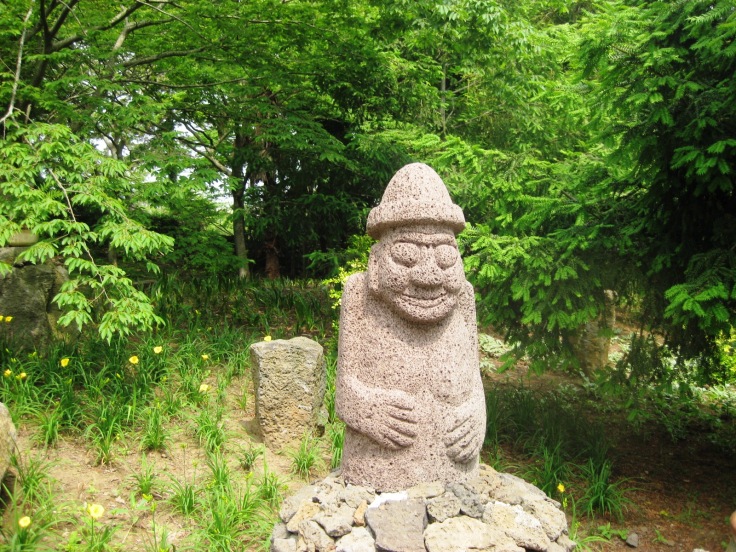
In Teju Island, South Korea there are phallic or mushroom shaped ancestor stone statues called dol hareubang. The hats of these statues are commonly referred to as phallic or mushroom-like. Nowadays, these dol hareubangs are the symbols of Teju Island.
Dol hareubang, Teju Island, South Korea (author’s picture).
Author and dol hareubangs, Teju Island.
The name dol hareubang derives from the Korean word for “stone” (dol 돌) plus the Jeju dialect word hareubang(하르방) meaning “grandfather” or “senior” (harabeoji [할아버지] in Standard Korean) and was coined in the mid-20th century…
At present time, they are considered to be gods offering both protection and fertility and were placed outside of gates for protection against demons travelling between realities.
There are three main theories as to the origin of dol hareubangs ; either that they were introduced by visitors from the sea, that they are a counterpart to the jangseungs (totem poles) of mainland Korea, or that they spread with shamanic mushroom culture.
Halla San (in Teju) has been named in Korean literature as one of the “Sam Shin San” (삼신산/ 三神山), or one of the Three Spirit Mountains. Each of these mountains are considered gateways to the spirit world, and have the Amanita muscaria (mushroom) growing in abundance. This mushroom is well known by the Siberians and is a possible origin for the Stone Grandfather.
The mushroom and its related imagery has had great importance in Korea, visible in ancient crowns, funeral urns, the Ship Jang Saeng Do (십장생도). The Dol Harubangs are a form of political propaganda, representations of the sacred powers of the mushroom, its associated deity, and attesting to the power of the Shamans (Wikipedia).
However, to me, the mushroom shape of these statues is not a symbol of the shamanic mushroom cult but is related to the cosmogeny religion which worshipped the Universe including the Sun.
As we know that in cosmogeny, the universe was created on the basis of the interaction of female element (nòng, yin) and male element (nọc, yang). It is composed of Three World (Upper, Middle and Lower or Under World) represented by a tree called Cosmic Tree (Three World Tree, Three of Life). The mushroom has the most appropriated shape of this Cosmic Tree. The dome of the mushroom portrays the Upper World. The lower part beneath the dome is the Middle World. The root is the Under World and the trunk (stem) is the World Axis. The Cosmịc Tree of the Thái people in Nghệ An Việt Nam is a mushroom. The main Nguyễn Xuân Quang type VI or Heger type I drum of Đông Sơn (Dongson) bronze drums has a mushroom shape. This mushroom shape drum such as Ngọc Lũ I drum is the symbol of Cosmogeny religion (Giải Đọc Trống Đồng Nòng Nọc, Âm Dương Đông Nam Á, Decipherment of the Southeast Asian Bronze Drums, in Vietnamese).
The Nguyễn Xuân Quang type VI or Heger type I drum of Đông Sơn (Dongson) bronze drums has a mushroom shape.
The dome of the mushroom portrays the Upper World. The lower part beneath the dome is the Middle World. The root is the Under World and the trunk (stem) is the World Axis.
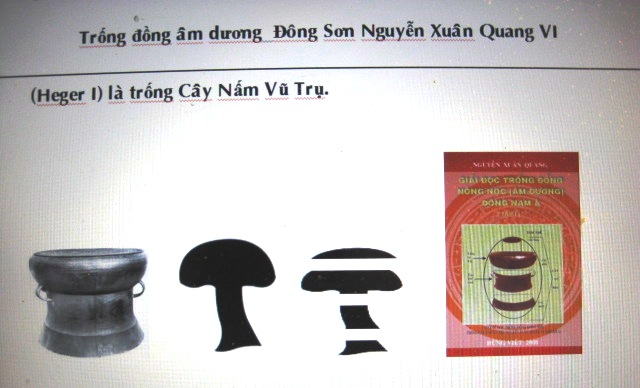
Noted that the Halla mountain which has been named in Korean literature as one of the “Sam Shin San” is related to Vietnamese Ba Vì (Trinity) Mountain. The Ba Vì Mountain also called TamTừng Mountain (ThreeTiered Mountain) portraying Three World Mountain or TảnViên Mountain (Parasol-Shaped Mountain) portraying Cosmic Mushroom.
So, evidently, I doubt that the Amanita muscaria mushrooms play any important role with the mushroom-shaped dol hareubangs.
Later, in the patriarch society, the sun worship became dominant, then the mushroom, seen on the yang side, represented the phallic. The mushroom shaped Dong son bronze drums seen on the yang side have the phallic form.
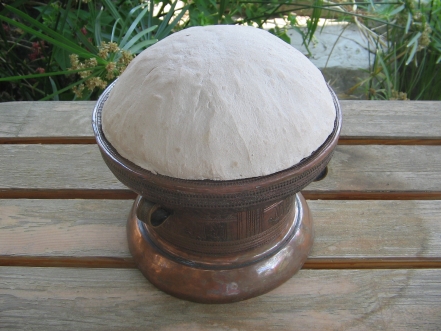
Nguyễn Xuân Quang VI or Heger I seen on the yang side has the phallic form.

A bronze drum has phallic/mushroom shaped form (Bảo Tàng Lịch Sử Thừa Thiên).
So, the mushroom cult seen in Korean culture is related to the cosmogeny religion, sun religion in general and particularly to the Vietnamese Đông Sơn drums, (symbols of the Vietnamese culture based on the cosmogeny and sun religions). This explains why the Korean funerary urns and ancient crowns have the shape of mushroom. The ashes of the dead were buried in the cosmic mushroom funerary urns for the dead can be reborn or to go to eternity. The Korean kings are the Sun kings, Son of the Sun god.
Therefore the dol hareubangs, considered to be related to the mushroom culture, are simply related to cosmogeny and sun religions and thus related to the Vietnamese Tiên Rồng (Bird-Snake, yang-yin) culture.
Obviously, the theory that “the origin of dol hareubangs introduced by visitors from the sea” is the most convincing. This also explains the difference between the Teju Island and the Korean peninsular culture.
Now, let find out where the dol hareubangs came from ?
Through my article The Relation between the Ancient Korean History and Vietnamese Ancient History (in Vietnamese) we know that the ancient Korean people had a root closely related to the Vietnamese Lạc Việt (Luo Yue).
The Kings of the Southern states of the Korean peninsular had the same legendary creator as the Vietnamese Hùng Kings. They were born from a cosmic egg or mundane egg. Sun worship is also very particular in Korean culture.
My literature works also demonstrate that the Vietnamese supreme Hùng Ancestor is the sun god Viêm Đế (Yen-Ti) and Hùng Vương, the historic Sun kings are the descents of Viêm Đế. One of the meanings of the term Hùng is male, penis, sun, dương (Sino-Vietnamese term dương means yang, male, sun).
Etymologically, Viêm Đế has the word Viêm meaning Hot and Đế meaning Pillar, Axis, Stake. Viêm Đế means Hot Pillar, Sun, Penis. The Hindu Shiva god symbolized by lingam (penis) has the same meaning “Pillar of Fire”. Shiva is related to sun god Viêm Đế.
Evidently, Hùng with the penis or phallic meaning must be seen under the view of the creation of the male or sun branch (not with a “porno” view).
It’s no doubt that the phallic or mushroom shaped dol hareubangs have the same DNA with the Vietnamese Hùng Ancestor.
How the dol hareubangs came to the Teju Island ?
In order to answer this question, we must find the foot prints of the dol hareubang from people related to the Bách Việt (Bai Yue). Two races we must look into are the Pacific Islanders and the Amerindians who originally were from South East Asia. All of them were related to ancient Việt people (Bai Yue).
a. Pacific Islanders
In Polynesia, phallic stone statues similar to dol hareubang were found in
. Bada Valley, Sulawesi Island, Indonesia.
Bada Valley or Napu Valley, located in the Lore Lindu National Park in Central Sulawesi contains hundreds of megaliths. Some locals believe they were used in ancestral worship. Some of the sources indicate that these statues show remarkable similarity to the stone statues of the Easter Island or with the stone figures found on Cheju (Teju) island in Korea (unspecial.org).
Maturu (‘Sleeping’).
Palindo (‘The Entertainer’) (deanmayerson.org).
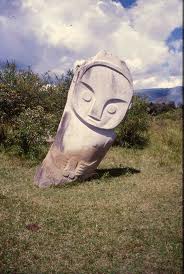
Note that Palindo is in an erect male genital position.
.Raivavae Island.
Raivavae is an island that is part of the Austral Islands in French Polynesia. There are monumental phallic ancestor stone statues that have been discovered.
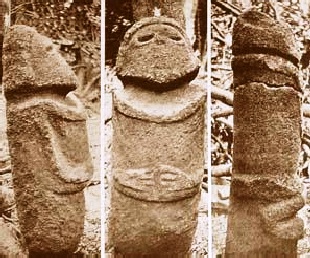
Phallic stone statue in Raivavae Island (humanpast.net).
Further, close to the South America coast is the Easter Island (Rapa Nui).
Rapa Nui was populated by people of Polynesian origins.
The island was most likely populated by Polynesians who navigated in canoes or catamarans from the Gambier Islands (Mangareva, 2,600 km (1,600 mi) away) or the Marquesas Islands, 3,200 km (2,000 mi) away. When James Cook visited the island, one of his crew members, a Polynesian from Bora Bora, was able to communicate with the Rapa Nui. The language most similar to Rapa Nui is Mangarevan with an 80% similarity in vocabulary (Wikipedia).
The most well known symbols of the Easter Island are the monolithic statues called moais
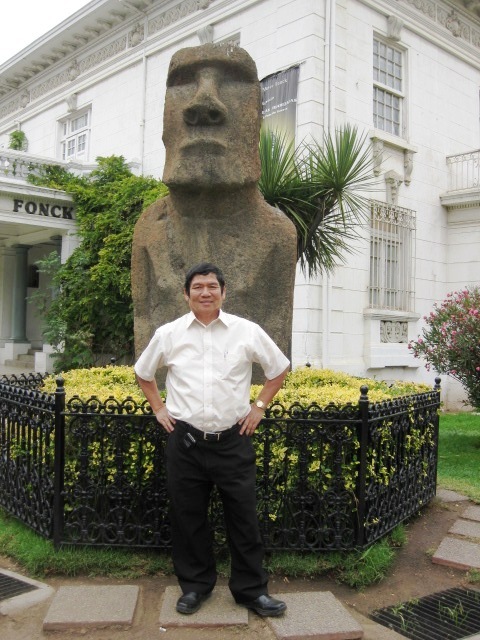
A moai from Easter Island placed in front of Museo Fonck, Valparaiso, Chile.
The islanders held the belief that the entire moai was a phallic symbol (bibliotecapleyades.net).
A moai with a phallic shaped hat (art.com)
Kneeling phallic shaped moai (highonadventure.com).
They are considered to be gods offering both protection and fertility.
However, many recent researches revealed that the moais are related to the sun worship, to the astrology and to the cosmology.
b. Amerindians
In the Recuay culture (a pre-Inca culture) in Peru, the ancestor stone statues are similar to the dol hareubangs.
Author and Recuay ancestor stone statue placed in front of Museum of Larco, Lima, Peru.
Recuay culture is a pre-Incan sun worship and ancestor worship similar to the Vietnamese and Korean cultures.
To verify by mean of the linguistics, in the Andean Indian language (including Quechua of the Inca, sun worshippers) the terms “ancestor”, “lineage ” and “penis” are relatives (Salomon 1991:20 ; Zuidema 1977:256). This is the same in the Vietnamese language. Based on the rules of historic sound change in the Vietnamese language, Vietnamese term giống (sex, lineage, race) relates to chống (supporting stick) and chông (pointed stakes used as booby trap, punji sticks). Stick, stake, punji stick are the symbols of penis.
As mentioned above, the Vietnamese supreme Hùng Ancestor is the sun god Viêm Đế (Yen-Ti) and Hùng Vương, the historic Sun kings are the descents of Viêm Đế. One of the meanings of the term Hùng is male, penis, sun, yang.
The similarity of these terms in the two languages shows that the ancient Peru and Inca people must be related to ancient Vietnamese people. Language also points out that the term ancestor, lineage, penis, male, sun are related. Therefore, the phallic statues in the Polynesia, in ancient Peru, in Teju Island are the symbols of the sun lineage, related to the Vietnamese people, decent of the sun god Viêm Đế. The Đông Sơn bronze drums are the icons of the sun worshipping Vietnamese race (Bai Yue), The People of the Sun.
In short, the phallic stone statues had the origin from South East Asia, territories of ancient Việt and spread out in two different ways. One way was to the North via Bering straight then down to America. Another way was down to the Pacific sea (Austronesia, Polynesia) and then to America.
If seen as phallic shaped statues, the Teju Island’s dol hareubangs are related to the Vietnamese Hùng Ancestor sun god Viêm Đế in the sun religion. The sun at the center of the tympanum of the Đông Sơn bronze drums proves this Vietnamese sun worshipping religion.
If seen as mushroom shaped statues, the dol hareubangs are related to the Vietnamese cosmogeny religion based on Tiên Rồng, Bird-Snake, yang-yin principle. The mushroom-shaped Đông Sơn bronze drums are the icons of the Vietnamese cosmogeny religion.
The dol hareubangs came to Teju Island either via South East Asian coast line or from the islands of the South Sea or perhaps from the group of small islands around Taiwan island.
We can conclude that these phallic/mushroom shaped ancestors statues found in South East Asia, Austronesia, Polynesia, Pacific Islands and in the American continent are related to the Cosmos/Sun worship religions and to ancient Việt people.
Kỷ niệm Lycée Français de Huế
Nguyen Dinh Tham – Truc Huy (LFH60)
.
Gửi Bạn Nguyễn văn Phước Ẩn (BP60),
Rất vui nhận được thư mới đây của Bạn đề ngày 22 Apr 2006. Cám ơn Bạn đã ghi lại thêm một số kỷ niệm dễ thương của hai năm học ở Lycée Français Huế hồi xưa. Đọc thư Bạn, mình phải công nhận Bạn là người có nhiều tình cảm và có tâm hồn gắn bó với những kỷ niệm đã qua, như Bạn viết : “Nhiều lúc trời mưa tự dưng lại nhớ lại những vũng nước đọng trong sân trường Lycée…”. Có nhiều chuyện tưởng chừng đã quên bây giờ được Bạn nhắc lại một cách rõ ràng đầy đủ chi tiết. Đúng như Bạn nói : “những năm 6è và 5è ở Lycée Hué khó mà quên lắm”.
Bạn hỏi mình đi tìm ‘tự do’ chắc là thảnh thơi lắm hay sao mà còn đem theo được mấy tấm hình kỷ niệm ‘staff’ (personnel) của Lycée Français Huế, xin trả lời Bạn mấy tấm hình kỷ niệm đó là của em mình Quỳnh-Chi mang theo được. Lúc chúng mình học Lycée Français Huế thì em mình (nhỏ hơn mình 4 tuổi) đang học École Primaire Française gần cạnh Lycée. Trong một courriel mới đây, em mình viết : “Merci pour les belles photos ; celle du Lycée Français me ramène à ma petite enfance où chaque jour j’avais l’habitude à y venir chercher Maman après la classe… Ma petite amie à l’École primaire française s’appelait Hông-Vân dont j’ai perdu le contact depuis que l’école fut déménagée à Dà Nang.”
.
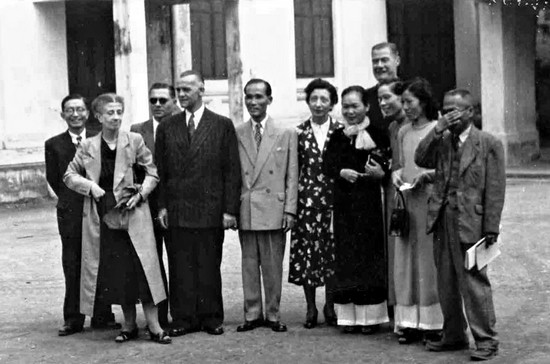
.
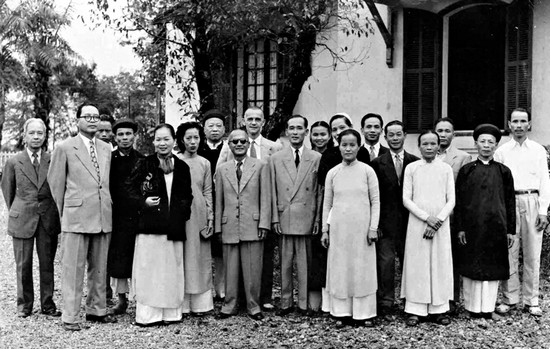
.
Trong mấy tấm hình kỷ niệm ‘staff’ này, với trí nhớ siêu đẳng Bạn đã nhận biết ra được khá nhiều người. Bạn còn nhận ra được hình 1 trên đây chụp ở sân École Primaire Française (gần cạnh Lycée Français) và hình 2 chụp ở nhà M. Dago, nằm ngay góc đường Hàng Đoát và đường Chaigneau (đường Lý Thường Kiệt) gần trường Providence. Mình thật khâm phục Bạn hết sức, nhớ cả người nhớ cả cảnh vật. Trí nhớ của Bạn đúng là một chiếc máy ảnh, đã ‘chụp hình’ người nào hay cảnh vật nào vào trong ký ức, thì cho dù trong bao nhiêu năm trời cũng như là một tấm hình mới chụp hôm qua hay hôm kia mà thôi.
Về các cô bạn trong lớp, mà mình chỉ còn nhớ 3 tên là ND, TT, NT, bây giờ được Bạn nhắc thêm một tên mới LM mà mình không còn nhớ. Mình rất vui được nghe Bạn tiết lộ thêm nhiều điều thú vị : “Nói đến ND, TT, NT và LM thì không những tụi mình đều biết, mà tất cả đám con trai học Lycée Hué lúc bấy giờ đều biết hết. Chàng nào cũng ngăm nghe nhưng toàn là thỏ đế, nên không chàng nào làm ăn gì được hết. Có nhiều chàng lại làm quen với moa để nhờ làm mai làm mối. Thật là buồn cười. Học cùng lớp với nhiều người đẹp lắm lúc cũng vất vả…” Rồi Bạn kể tiếp : “Tuỳ theo mùa, moa ngồi ngay sau lưng hay được các nàng passer kẹo, đậu phụng rang hay me chua v. v…”. Chuyện đã 50 năm hơn, bây giờ mình nghe Bạn kể lại vẫn còn … cảm thấy hơi ấm ức phân bì với Bạn đấy, vì hình như mình không hề được các ‘nàng’ passer kẹo bánh như Bạn cả. Nhưng mình nói đùa cho vui vậy thôi, vì Bạn ngoài trí nhớ ‘éléphant’ phi thường còn là “người đệ nhất tài hoa” (như lời DT) thì mình đâu dám đòi hỏi được như Bạn nhỉ ?
Tuy không được ăn kẹo bánh của các nàng cho, nhưng mình còn nhớ, cuối năm 5è, mình được ít cô nàng trong lớp trao cho mấy cuốn sổ lưu niệm để viết ít giòng lưu bút (mỗi người một trang) vào đó và mình cũng được ít nàng viết vào cuốn sổ lưu bút của mình nữa. Nhưng tiếc rằng về sau cuốn sổ lưu niệm của mình bị thất lạc hồi nào không hay, có lẽ do những lúc gia đình dọn nhà thay đổi chỗ ở hoặc lúc cả gia đình mình rời bỏ Huế để vào Nam.
Ôi ! biết bao kỷ niệm thân yêu chúng ta còn giữ lại trong tâm hồn ! Thỉnh thoảng mỗi khi muốn hồi tưởng lại một vài kỷ niệm thân yêu của một thời đã qua, mình lại leo lên căn gác quạnh quẽ cô liêu của miền ký ức địa đàng xa xưa nhưng vẫn còn đượm chút hương xưa phảng phất đâu đây, và mở nắp cái rương hòm đầy phấn bụi mốc meo của thời gian – cái rương hòm của ký ức mà người ta thường cất giữ những thứ lỉnh kỉnh của quá khứ, vất đi không nỡ mà cất giữ cũng chẳng mấy khi dùng đến – rồi lục lọi một cách bâng quơ dưới đáy rương hòm ký ức và bất ngờ tìm lại được những hình ảnh đã phai mờ, những khuôn mặt thân thương đã lâu ngày không gặp lại… Lúc đó mình như được sống lại với những người xưa và những cảnh vật đã quen thuộc, những kỷ niệm vui buồn của một thời đã qua, và trong lòng không khỏi cảm thấy chút gì bồi hồi lưu luyến thương nhớ thiết tha. Trong một thư mới đây, bạn DT viết cho mình rất chí tình : “Toa nói đúng : không có toa trong những kỷ niệm lỉnh kỉnh. Chỉ có những kỷ niệm lỉnh kỉnh chúng nó ở trong toa. Bứt (arracher) con người ra khỏi kỷ niệm, dễ thôi. Bứt kỷ niệm ra khỏi con người, dường như khó hơn.”
Thư viết cũng đã khá dài, Bạn cho mình tạm ngừng ở đây nhé. Thân mến chào bạn PA và chúc bạn và gia đình luôn luôn vui mạnh.
27 – 4 – 2006
NDT 🙂
http://www.saigonline.com/truc_huy/lfh_2.htm
P.S. Bạn DT ơi, Bạn nói rất đúng : “Kỷ niệm không là gì, khi thời gian bôi xoá. Kỷ niệm là tất cả, khi lòng ta muốn ghi.”
Hội An Thời Thơ Dại
Ý niệm về phố thị đến với tôi từ Hội An, ngày lên bốn. Rời ngôi làng quê lác đác nhà, với những con mắt đèn dầu nhập nhèm đêm đêm gắng sức nháy gọi nhau qua những cánh đồng trống hoang, tôi bước vào một thế giới chi chít nhà, chói lòa ánh sáng.
Mẹ đi học nghề, Ba đi làm, trong gian nhà thuê nhỏ, ba chị em trứng gà trứng vịt thơ thẩn chơi cùng trẻ em hàng xóm. Kỳ thú sao, những đồ hàng nhựa rực rỡ sắc màu. E ngại quá, những trò đùa láu lỉnh của bạn bè thành phố.
Xóm lao động nằm gần khu biệt thự, buổi chiều tiếng người cãi nhau trong mùi xào nấu, thoảng vào một âm thanh dìu dặt mơ hồ mà sau này tôi mới biết ấy là những khúc nhạc của Chopin. Cách nhau một con đường, căn nhà phủ đầy hoa ti gôn và những đứa trẻ mặc áo đầm trắng, nơ hồng, ẩn hiện như một thế giới xa vời. Nửa đêm, trong những cơn mơ tuổi thơ chập chờn, tôi giật mình tỉnh giấc bởi tiếng la : “Tau xởn, tau xởn” và bác Mười hớt tóc chạy quanh, tay nhăm nhăm kéo, rượt theo bác gái chân quíu vào nhau với mớ tóc dài xõa xượi. Buổi tối ấm áp cả nhà quây quần trên chiếc chõng tre cập kênh. Tô nước phở tỏa hương thơm phức đưa những muỗng cơm rất trơn. Có lần bị mất điện, đứa em thứ hai dẫy chân dỗi ăn, chiếc đèn dầu ngã vào chân tôi làm thành một vệt bỏng dài.
Mùa hè, trời đứng gió, những con thiêu thân bay đầy các bóng đèn. Suốt mấy tháng, ba mẹ tôi cứ thao thức vì đứa em nhỏ chưa đầy năm đi tướt. Khuôn mặt như thiên thần của em xanh lướt, một vẻ đẹp mong manh lạ lùng làm ai đi qua cũng ngoái nhìn. Mùa thu, chợ ven sông đầy rau xanh và quả lạ. Nhớ làm sao món quà mẹ chia cho. Trái thị vàng ươm chơi chuyền rất vừa tay, lòng sung sướng vì lần đầu tiên có cái đáp tặng bạn. Chơi mỏi, cả lũ nhấm nháp, những chiếc răng sữa nhằn mãi cái hạt thị như kéo dài một niềm vui không chán. Sớm mai, nhiều lần cô bé là tôi đứng ngẩn ra nhìn chú Phùng, người đàn ông bị liệt chân, hai tay mang dép, lết ra từ Viện Tế bần. Như hẹn trước, những người đàn bà đội những bó rau muống to và dài, xanh ngút ngát, đi như chạy từ ngoại ô vào, một vài bàn tay khẽ khàng lật chiếc mũ vải nhàu nhĩ trên đầu ông, nhét vào đó đồng tiền lẻ ẩm ướt, mở hàng.
Một chiều đầu năm, tò mò đi theo những người tảo mộ. Vui chân, không biết đường xa, hai chị em tôi lạc vào một thế giới lạ lùng. Một thành phố khác : thành phố của mộ bia. Bóng chiều dâng lên nhanh quá. Mắt tôi đầy cỏ may và nhang khói. Đôi chân bé ngập trong mặt đất bao la, rụng rời vì mỏi và một nỗi hãi hùng chưa từng thấy. Những tiếng quạ bay quàng quạc làm chúng tôi giật thót từng hồi. Đi loanh quanh không thấy một bóng người, trong nỗi tuyệt vọng cùng cực, chúng tôi ôm nhau òa lên khóc. Lúc ấy, tiếng lê người quen thuộc của chú Phùng vọng đến. Lựa lúc chợ tàn, xin được bó hoa ế cuối ngày, chú lết ra thắp nhang cho vợ.
Hội An lần ấy được bồi thêm lớp phù sa mới sau này, với những cuộc lưu trú ngắn và ghé qua thoáng chốc. Mùa hè năm 7 tuổi theo cha, bỡ ngỡ trong thế giới sách vở và phim ảnh. Sẽ không còn cuốn sách nào hấp dẫn hơn cuốn sách Hồng Ông Đồ bể và Cái ấm đất. Sẽ không tìm thấy cuốn truyện có minh họa nào lộng lẫy hơn Chú bé tí hon và Bạch Tuyết và bảy chú lùn của Perrault. Tôi đã đọc chúng trong tiếng sông rạt rào chảy sát sau nhà trọ, hay là tiếng đập háo hức của trái tim mình, nào có biết. Tôi đã ngoạm sâu vào trái ổi xá lị lòng đào ngọt mềm và hình dung nàng Bạch Tuyết ngây thơ cắn vào trái táo đỏ của bà Hoàng hậu. Nhẩn nha thưởng thức dĩa xôi buổi sáng vàng ươm, tôi thèm chén nước vối của anh Ba (*) hạnh phúc.
Với Hội An, tôi có khái niệm ngày cuối tuần. Và thứ bảy là biểu tượng của sự thụ hưởng chỉ dành cho người thành thị : bộ phim đầu tiên tôi được xem là ở cái rạp hát duy nhất của thị xã. Hoa mắt bởi những tấm affiche đầy màu sắc, ngẩn ngơ vì những bóng nam thanh nữ tú, ngập tai bởi những âm thanh và cuối cùng sững sờ vì những hình ảnh và câu chuyện trong phim, tôi bị một đêm mất ngủ. Từ đó, tôi hiểu rằng có một thế giới mênh mông ngoài kia luôn mời gọi những tâm hồn khát khao phiêu bồng. Cũng hình thành từ đấy, cái thú dạo chơi và ngắm nhìn. Những con phố hẹp quen- mà- lạ của Hội An, chân đi không đủ mỏi, khi về lòng cứ bâng khuâng. Mỗi lần qua chùa Cầu, bước tôi rón rén, tim tôi hồi hộp, mắt cứ dán vào những chú chó gỗ lưỡi khô trong ánh chiều chạng vạng. Nhiều năm sau, nhớ lại, tôi chợt nghĩ, chiếc cầu bé nhỏ kỳ lạ này lại là một ám ảnh lớn nhất đối với tôi về cây cầu.
Khi xây cầu để nối đôi bờ, hình như nhà kiến trúc còn muốn gửi tặng con người Hội An một chiều nối khác thuộc về tâm tưởng. Từ ấy, những bèo bọt của bể dâu đã dừng lại bên ni cầu, giữ cho Hội An cái trong ngần tĩnh lặng. Dòng sông, cây cầu, thế đất và cái tên được đặt như một ước vọng, đã làm nên phong thái người Hội An. Ký ức tôi ghi lại hình ảnh một chị Thúy tóc mềm lả lướt, giọng nhẹ bâng. Những người phụ nữ Hoa da trắng mát, mắt dài ngồi lơ đãng nhìn người qua lại ở cửa hàng Phi Anh, Phi Yến, sang cả và lãng mạn. Dì bán rau gọn gàng và tinh tế trong trang phục và gánh hàng. Bác Tàu già gầy gò đen điu đội nón nan, cười nhăn nheo bên phố rêu, thong thả múc những chén lục tào xá ngọt lừ bốc khói.
Một vài lần hiếm hoi, cả nhà được “kéo ghế”. Tôi nhớ mãi cái quán cao lầu gió hiu hiu. Tô nước dùng nóng, ánh một váng mỏng mơ hồ quyện vào màu xanh non của húng quế. Những sợi cao lầu chạm vào đầu lưỡi, thoạt tiên nghe hơi sượng, rồi dìu dịu, đầm đậm, vương vấn mãi một vị không thể gọi nên bằng lời của lúa gạo và tro than, của đất và nước sông Hoài. Khi ra về, trên tay trĩu nặng chiếc bánh su sê xanh biếc màu lá dừa như món đồ chơi xinh, ấm áp nghĩa tình.
Thế mà đã lâu lắm rồi tôi không trở lại. Đứa em cùng thơ thẩn ngày xưa đã bay theo một cung đường khác khi chưa đến tuổi 20. Phố thị ấu thơ vẫn canh cánh bên lòng một lời hẹn. Rồi tôi sẽ về. Sẽ cùng lang thang đi tìm dấu chân thơ dại. Sẽ cùng ngồi thả chân trên bờ nước sông Hoài, tìm chút bình yên. Dẫu mùa trăng hay đêm sao, Hội An ơi, hãy thức đợi tôi về.
NGUYỄN THỊ THANH XUÂN
